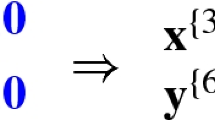Abstract
We consider a way to construct perfect codes capable of correcting 2 or more deletions using design-theory. As a starting point we use an (ordered) block design to construct a perfect deletion correcting code. Using this code we are able to construct more perfect deletion correcting codes over smaller or larger alphabets by removing or adding symbols in a smart way.
In this way we are able to find all perfect 2-deletion correcting codes of length 4, and all perfect 3-deletion correcting codes of length 5 with different coordinates. The perfect 3-deletion correcting codes of length 5 with repeated symbols can be constructed for almost all possible alphabet sizesv, except forv=13, 14, 15, and 16, and forv≡7, 8 (mod 10),v≥17. For these values ofv we are neither able to prove the existence, nor the non-existence of perfect 3-deletion correcting codes of length 5 over an alphabet of sizev.
Similar content being viewed by others
References
L. Calabi and W. E. Hartnett, A family of codes for the correction of substitution and synchronization errors,IEEE Transactions on Information Theory, Vol. IT-15, No. 1 (1969) pp. 102–106.
L. Calabi and W. E. Hartnett, Some general results of coding theory with applications to the study of codes for the correction of synchronization errors.Information and Control, Vol. 15 (1969), pp. 235–249.
M. Hall, Jr., and W. S. Conner, Jr., An embedding theorem for balanced incomplete block designs,Canadian Journal of Mathematics, Vol. 6 (1954) pp. 35–41.
H. Hanani, The existence and construction of balanced incomplete block designs,Ann. Math. Stat., Vol. 32 (1961) pp. 361–386.
H. Hanani, On balanced incomplete block designs with blocks having five elements,Journal of Combinatorial Theory (A), Vol. 12 (1972) pp. 184–201.
D. H. L. Hollmann, A relation between Levenshtein-type distances and insertion-and-deletion correcting capabilities of codes,IEEE Transactions on Information Theory, Vol. IT-22, No. 4 (1993), pp. 1424–1427.
V. I. Levenshtein, Binary codes capable of correcting deletions, insertions, and reversals (Russian),Doklady Akademii Nauk SSSR, Vol. 163, No. 4 (1965) pp. 845–848; (English),Soviet Physics Doklady, Vol. 10, No. 8 (1966) pp. 707–710.
V. I. Levenshtein, Asymptotically optimum binary code with correction for losses of one or two adjacent bits,Problems of Cybernetics, Vol. 19 (1967) pp. 298–304.
V. I. Levenshtein, On perfect codes in deletion and insertion metric (Russian),Discretnaya. Mathematika, Vol. 3, No. 1 (1991) pp. 3–20; (English),Discrete Mathematics Applied, Vol. 2, No. 3 (1992) pp. 241–258.
J. H. van Lint and R. M. Wilson,A Course in Combinatorics, Cambridge University Press (1992).
F. F. Sellers, Bit loss and gain correction code,IRE Transaction on Information Theory, Vol. IT-8, No. 1 (1962) pp. 35–38.
D. J. Street and J. Seberry, All DBIBDs with block size four exist,Utilitas Mathematica, Vol. 18 (1980) pp. 27–34.
D. J. Street and W. H. Wilson, On directed balanced incomplete block designs with block size five,Utilitas Mathematica, Vol. 18 (1980) pp. 161–174.
E. Tanaka and T. Kasai, Synchronization and substitution error-correcting codes for the Levenshtein metric,IEEE Transactions on Information Theory, Vol. IT-22, No. 2 (1976) pp. 156–162.
G. M. Tenengolts, Class of codes correcting bit loss and errors in the preceding bit (Russian),Avtomatika i Telemekhanika, Vol. 37, No. 5 (1976) pp. 174–179; (English),Automation and Remote Control, Vol. 37 (1976) pp. 797–802.
G. Tenegolts, Nonbinary codes, correcting single deletion or insertion,IEEE Transactions on Information Theory, Vol. IT-30, No. 5 (1984) pp. 766–769.
J. D. Ullman, Near-optimal, single-synchronization-error-correcting code,IEEE Transactions on Information Theory, Vol. IT-12 (1966) pp. 418–424.
Author information
Authors and Affiliations
Rights and permissions
About this article
Cite this article
Bours, P.A.H. On the construction of perfect deletion-correcting codes using design theory. Des Codes Crypt 6, 5–20 (1995). https://doi.org/10.1007/BF01390767
Received:
Issue Date:
DOI: https://doi.org/10.1007/BF01390767




